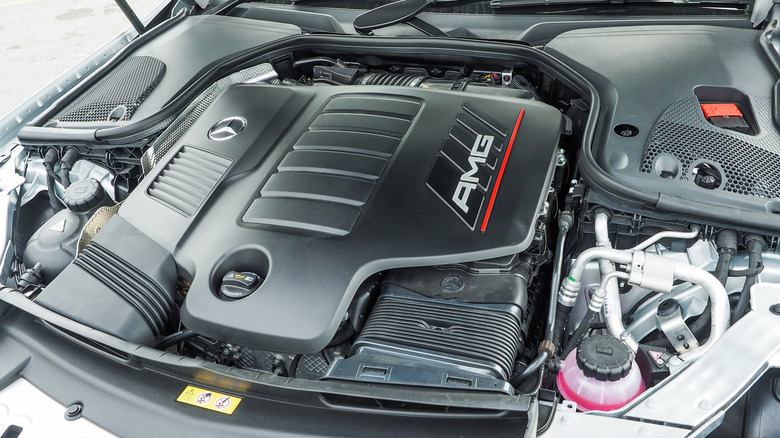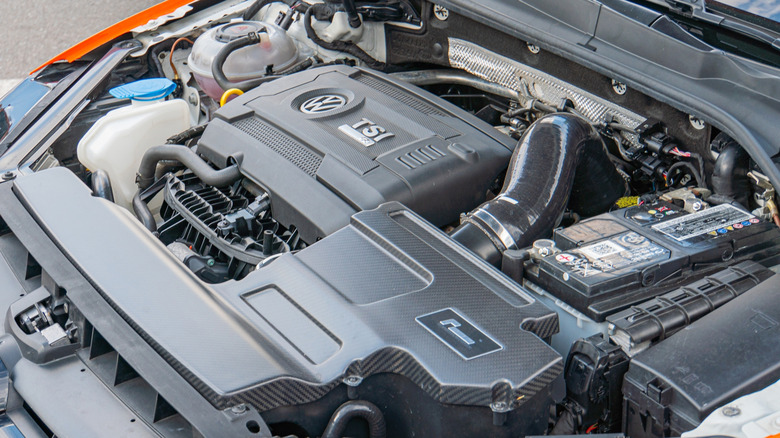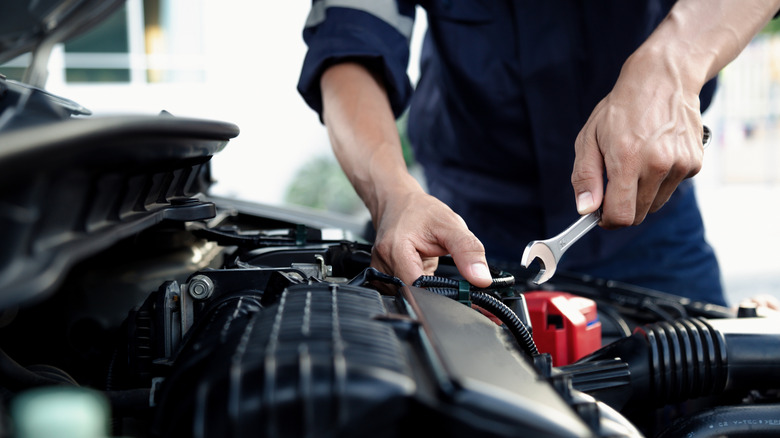Does Your Car Really Need An Engine Cover? (And Can You Take Them Off?)
Some car enthusiasts see the engine as its centerpiece, the jewel in the crown that should be proudly displayed wherever possible. Modified, high-performance cars often have a blower, shaker scoop, or velocity stack rising above the hood, while classic hot rods do away with hoods and engine fairings altogether. At car shows, the hood is invariably raised so fellow enthusiasts can drool over engines in all their muscular glory.
For decades, production cars were not much different: raise the hood, and you would see radiators, fans, valve covers, manifolds — along with the plumbing and electricals. Lift the lid on a car today, and you'll likely see a heat-resistant plastic, aluminum, or carbon fiber engine cover — from fender to fender, front to firewall – usually highly stylized and bearing the manufacturer's logo.
Engine covers serve a similar purpose to a carpet or a hubcap. It looks tidy and keeps parts underneath clean and undamaged, while reducing heat, dust, and noise in the cabin. Just like a carpet or hubcap, if an engine cover is removed, your car will keep running just fine — in most cases. While tossing out an engine cover is safe for most models, it is not recommended for others. Some covers have breather tubes or air filters built in, so it is best to check with a qualified mechanic before throwing caution — and your engine cover — to the wind.
More than just a cover
Some luxury car brands, like Mercedes-Benz, incorporate air filters into their engine cover assemblies. This is also the case with some generations of the Volkswagen Jetta and Volkswagen Passat. If you want to remove a combined engine cover and air filter, you will need to fit a replacement air filter — but bear in mind that aftermarket air filters do not always improve performance.
Intake of dirt and debris into an engine can cause premature wear, so an air filter should always be in place while it is running. Likewise, any PCV system breather tubes, pipes, or hoses should remain connected. Disconnecting or plugging breather tubes, or tampering with PCV valves, can cause noxious, oily gases and unburned hydrocarbons to vent out not only into the atmosphere, but potentially into your cabin as well. This can also cause uneven idling, excessive crankcase pressure, and dirtier oil.
An engine cover provides thermal insulation, trapping heat in the engine bay, helping get your engine up to operating temperature more quickly. Your car's interior also gets warmed more quickly on cold mornings, as the climate control draws its heat via a secondary radiator, or heater core, within the cabin. The cover has a safety role, too, keeping inexperienced fingers away from electrical components, fuel systems, and moving parts. Engines have external belts that drive such things as power steering units, water pumps, alternators, and air conditioning compressors, and the engine cover helps keep hair, jewelry, or loose clothing from getting caught in these pulleys.
It can be a barrier to maintenance
On the one hand, an engine cover helps keep dirt away from the engine, reducing the risk of corrosion, electrical shorts, or other malfunctions. On the other, it makes it more difficult to spot potential problems — such as corrosion, leaks, blockages, or wear — in the first place. And while dipsticks and oil fillers are usually readily accessible, car engine covers can be a barrier to performing some of the basic maintenance operations that help your car run more smoothly.
Whether carmakers designed it this way or not, engine covers make it more likely that a car owner will choose to have a dealership service over a DIY option, which provides a financial windfall for the car brand. Some mechanics argue that engine covers add an unnecessary step in the repair process, suggesting there should be an extra labor charge for working on engines that have a cover.
In 2022, Volkswagen recalled its eighth-generation GTI Golf and Golf R models after finding the engine covers could come loose, melt, or even cause a fire. Volkswagen's solution? It removed engine covers from affected vehicles until a new part could be made. This suggests these vehicles, at least, could be temporarily operated without engine covers. If your car engine cover does not incorporate an air filter and does little more than cover the engine while looking pretty, then disposing of it shouldn't cause any major hiccups in the short term.


